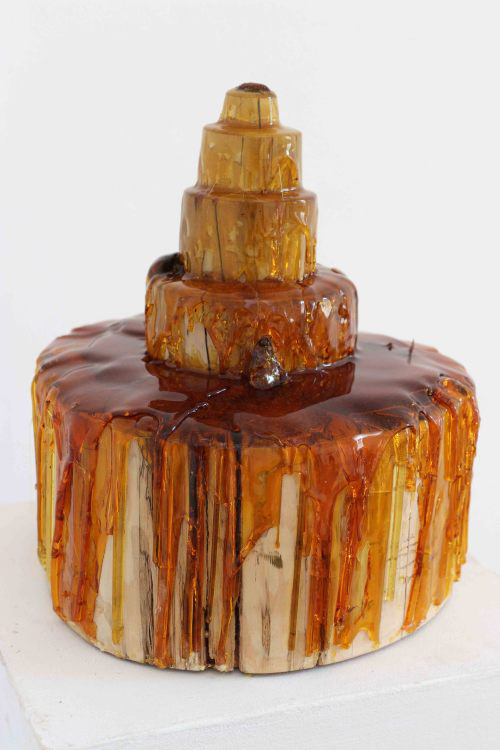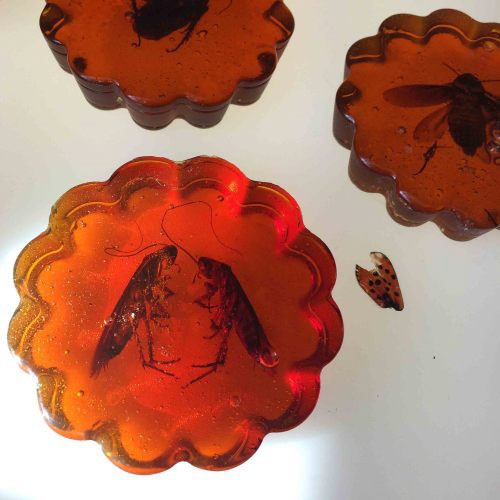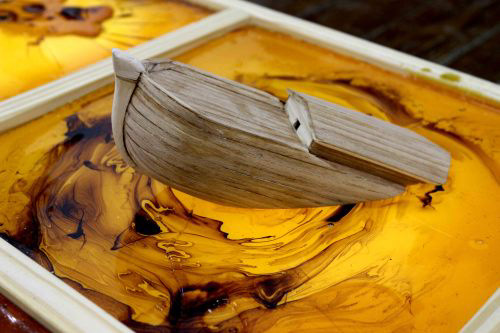

Fine Art Exhibition
Good Times on Earth
A final year exhibition for my Bachelor of Fine Arts degree
In Good Times on Earth, concepts of subversion, aestheticization and the grotesque are explored through an emphasis on materiality and the evocative quality of objects. There is a play between acidic and nontoxic, superficial and real, and the micro and macro. This staged “End of the World Party” attempts to highlight the superficial way within which many of us deal with our current ecological crisis.
Above: "Grenades" (series)
Below: "Condolences"
Pine cones, gum rosin, ferric chloride, disco balls
Dimensions variable
2015
Ferric Chloride stained material
5000mm x 400mm
2015


Above: "Forest Cake" (series)
Pine logs, gum rosin, cockroaches
Dimensions variable
2015


Above Left: "Forest Cake" (series)
Pine logs, gum rosin, cockroaches
Dimensions variable
2015
Above Right: "Tart" (series)
gum rosin, cockroaches
1cm x 5cm
2015


Above: "Balloon"
Lithographic crayon on mylar
700 x 1000mm
2015
Above: "Ziggurat"
Framed lithographic print
700 x 1000 cm (print size)
2015
Above: Video still from "Champagne Supernova in Oil"
2015
Above: "Champagne Supernova in Oil"
Video of champagne and motor oil.
2015

Above: "Tread Lightly" (detail)
Dancefloor made with LED lights, pine wood, gum rosin and bitumen
2015
Aesth / ethics and the Aestheticization of Violence
Brief thesis introduction concerning Good Times on Earth
AESTHETICS: The study of taste and beauty in the history of art - the shift from the former term to the latter implied a shift from a sensual pleasure to a more intellectualized pleasure in the appreciation of art (Shiner, 2001: 18).
ETHICS: moral principles that govern a person’s or group’s behavior.
The importance that context can play towards meaning in aesthetics can be seen in the example that Yuriko Saito provides for viewing an aesthetically pleasing lawn in Future Directions for Environmental Aesthetics (2010). Had you known that the perfection of the green colour was the result of harmful chemicals that impacted the rest of the lawn’s surroundings, might you see the lawn in a different light? After becoming aware of the environmental harm that its perfection poses and the invisible toxicity behind the appearance, its innocent beauty transforms into a morbid gorgeousness (Saiko 2010: 381-82).
In recent decades, oceans (which were, by nature, the realm of slow change) have undergone drastic changes (Nixon 2011: 200). Due to the proliferation of atmospheric pollution uptake by the ocean, the PH level of the ocean has decreased (in other words, it is becoming more acidic) (Binde 2007: 78). Essentially, the acidification of the ocean is linked with global warming (Archer 2009: 114). The timely nature of this process, which takes years or generations to witness, is similar to the delayed visible effects of war-inflicted catastrophes such as nuclear bombings. In addition to these human-caused activities enacting a slow violence upon Earth (Nixon 2011: 200), damages caused by oil spill catastrophies and the introduction of invasive species threaten not only the immediate environment and its living inhabitants, but the sustainability of the planet as we know it.
References
- Archer, D. 2009. The Long Thaw: How Humans Are Changing the Next 100,000 Years of Earth’s Climate. Princeton University Press. Available: http://www.jstor.org/stable/j.ctt7s0gb [Last accessed July 2016].
- Binde, J. Ed. 2007. Making Peace with the Earth. 2007. United States: United Nations Educational, Scientific and Cultural Organization, and Berghahn Books. 75 - 81.
- Nixon, R. 2011. Slow Violence and the Environmentalism of the Poor. Cambridge, Massachusetts, and London: Harvard University Press. Available: http://www.jstor.org/stable/j.ctt2jbsgw [Last accessed July 2016].
- Saito, Y. 2010. Future Directions for Environmental Aesthetics. Environmental Values. 19(1):373-391. Available: http://www.jstor.org/stable/25764256 [Last accessed July 2016].
- Shiner, L. 2001. The Invention of Art: A Cultural History. Chicago: University of Chicago Press.









